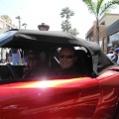Wayne,
The units of measure can make a huge difference in understanding power. The confusion about HP and TQ is that people call them different things. So they think they are different things, when they are actually the same thing. Which is why I suggested calculating both as NM of force. It eliminates the confusion. HP is TQ/Time. They are the same thing, referred to as different things depending on where you plot them on a timeline.
The power at the crank is of course identical regardless of the rest of the drive train. But we are talking about measuring wheel horse power. Which means we must take into account the gearing.
The express purpose of gears is to multiply or divide force. So since you are measuring the power at the wheels, after it has gone through the gears, the ratio of the gear you are in is directly proportional to the amount of power/time. People do 4th gear pulls in a Subaru because it is the gear closest to 1:1, the actual crank power minus drivetrain loss. The total amount of power/time will absolutely be different depending on the gear, its what the gears are there for.
Power loss in a drivetrain is caused by changing the direction of the force, the power required to rotate the mass of the components and heat. Not by the gear ratio.
Gears change the % of power delivered at a given time in reference to the rotational speed of the final output (the wheels).
The crossover will absolutely change dependent on the amount of time elapsed to reach a certain RPM. Its what the crossover measures.
If the volume of the system remains the same, an increase in CFM input will increase PSI and the converse. As RPM rises, in order to maintain an equal PSI you must increase CFM because the engine is taking more volume from the system.
And the CFM:PSI in a compressor map is a direct correlation to piping volume. The smaller the volume of the piping, the higher the pressure at a given CFM.
If the piping is too small, the required PSI to flow the same CFM increases too much. The turbo then has to spin faster to overcome the existing pressure to meet the same CFM. Creating unwanted heat and pushing you out of the efficiency range.
If the piping is too large, the turbo must flow more CFM to maintain positive pressure relative to atmosphere and the volume consumed by the engine. Again having to spin too fast and creating excess heat pushing you out of the efficiency range.
The CFM:Power ratio in a forced induction engine is not 1:1. The engine only operates at 100% efficiency under boost. If you are under boost you are not at lambda, you are rich. Its generally closer to 1:1.45 depending on how rich you are running at full boost.
And yes you would want to detune it through the mid range. If you are trying to achieve HP (X) at at 9000RPM you need a turbo that will flow that CFM. If the turbo is capable of flowing CFM for HP (X) at 9000RPM it will flow considerably more at 5500 RPM, where your HP/TQ number are most likely going to cross. Hence if you can spool it up that fast, you are going to well exceed your desired peak HP number. You will need to bleed of WG gas to keep the power at the level you want from the crossover to redline. IE detune it through the midrange 38-5500 RPM. If you don't start slowing spool down a few 1000 RPM before your goal, you will overshoot unless you have an external WG.
If you choose a turbo that has a max CFM equal to the power that you want at crossover, you will be horribly disappointed. If it is flowing its max efficient CFM at 5500 RPM it will never hold that CFM to 9000 RPM. It will hit the desired number and trail off rapidly in direct proportion to RPM.
And it is way easier to deal with a power curve that builds and then stays even to redline than one that has a massive spike at 3800 RPM and then drops at 5500. The last thing I want to drive is a light, rear engine car that makes way more power prior to crossover and then drops like a rock. Is a good way to downshift, break the tires loose and kill yourself.
All HPDE that I'm aware of is based on time. But none I know of other than a handful of obscure drift categories have pw/wt requirements. And they generally curb allowed power via restrictors. But I certainly don't know all the rules for all the classes of every kind of racing.
But giving up max high end power for quicker low and midrange power is normally a pretty good tradeoff for things like gymkhana and rallycross.
- Home
- Latest Posts!
- Forums
- Blogs
- Vendors
- Forms
-
Links

- Welcomes and Introductions
- Roadster
- Type 65 Coupe
- 33 Hot Rod
- GTM Supercar
- 818
- Challenge Series
- 289 USRCC
- Coyote R&D
- Ask a Factory Five Tech
- Tech Updates
- General Discussions
- Off Topic Discussions
- Eastern Region
- Central Region
- Mountain Region
- Pacific Region
- Canadian Discussions
- Want to buy
- For Sale
- Pay it forward
-
Gallery

- Wiki-Build-Tech


 Thanks:
Thanks:  Likes:
Likes: 

 Reply With Quote
Reply With Quote








